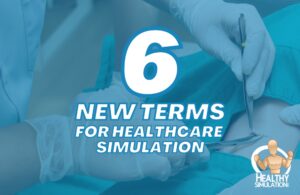Surgical Simulation
Surgical Simulation is a specialization of Medical Simulation in which healthcare trainees and healthcare professionals learn modern surgical interventions with the use of surgery simulator technology. Surgery Simulations can range from simple suture practice for a single learner to advanced robotic Surgery Simulations for an entire interprofessional surgical team. Healthcare professionals who focus on education through the use of Clinical Simulation methodologies and technologies should be aware of the various aspects of Surgical Simulation, such as recent technological advancements, such as virtual reality.
The Case for Surgical Simulation
The surgical field has long been one of the top medical specialties to incorporate healthcare simulation, alongside the field of anesthesiology. This is due, in part, to the high costs inherent to train surgical learners and trainees and a lack of access to surgical training materials like cadavers. The stresses and risks to learn surgical techniques in an “on-the-job” fashion makes this a less than ideal option from a patient safety perspective also. Surgical learners and trainees need a high volume of exposure to surgical procedures to be able to properly train and acquire the coordinated hand-eye movements needed to utilize specialized surgical tools and the manipulation of biologic tissue.
Sponsored Content:
In response to these challenges in the surgical training process, surgery simulators from companies like VirtaMed, Surgical Science, Simulab and other vendors have been shown to reduce costs, lessen medical errors, and decrease lethal infection rates and improve provider performance. For example, a technique such to learn to place a central line is an essential skill for emergency medicine and internal medicine physicians to acquire. However, central line access can be difficult for medical students to get an adequate amount of exposure and practice to this clinical skill while limiting the risk to themselves and their patients. Research has shown that adaptation of a specialized Surgical Simulator, known as a SimuLab CentraLineMan, can provide dramatic cost savings and better prepare students at the critical moment when acquisition of a central line procedure skill is needed. This in turn leads to reduction of central line-associated bloodstream infections at an institutional level.
Types of Surgical Simulators Available
High-fidelity surgery simulators exist but are not limited to specialty fields of laparoscopic surgery, neurosurgery, endoscopic surgery, trauma surgery, cardiac surgery, and interventional surgery. These products can serve a dual purpose which is to help educate new students as well as assistance to current surgical professionals who wish to perfect their mastery of specific surgical skills and techniques. Surgical simulators can enhance the educational process via integrated learning curriculums, performance-based statistical reports (such as tracking the number of movements a surgeon makes while completing a task), and screen records for surgical debrief and assessment purposes.
HealthySimulation.com is dedicated to providing the latest Surgical Simulation news and resources from around the world. To follow along, sign up for our free medical simulation email newsletter, follow @HealthySim on Twitter and @HealthySim on Facebook, or follow our HealthySimulation.com Linkedin Company Page! Sponsored Content:
Because of their valuable real-time 3D rendered animation, haptic feedback devices, and ability to manipulate realistic hardware instrumentation, the surgical community has readily adopted high-fidelity surgical simulators. For example, The Fundamentals of Laparoscopic Surgery (FLS) certification by SAGES requires a skills demonstration through a timed performance of Surgical Simulation exams to qualify for a license. This demonstrates the confidence of educators and credentials of experts in the ability of Surgical Simulation to translate into actual skills proficiency.
Specific Surgical Simulator Brands
Leading brands that provide robust Surgical Simulation training systems include Simulab, Elevate Healthcare (formerly CAE), VirtaMed, 3D Systems, Simbionix, now a part of Surgical Science, Symgery (formally known as OSSimTech), Maxon, Simulab, and Medical-X, among others. These surgical simulators can help surgical learners in a variety of capacities, which includes increasing their competence in the these surgical areas:
- Chest tube insertion
- Lumbar puncture
- Needle Decompression
- Tracheostomy
- Pericardiocentesis
- Diagnostic Peritoneal Lavage
- IV Cutdown
- Laparoscopy
- Endoscopy
- Ultrasound-guided procedures
- Arthroscopy
- Urologic procedures such as TURP or TURB
- Bronchoscopy
- Spinal surgery
View the LEARN CE/CME Platform Webinar Operating Room IPE Team Training with Surgical Simulation to learn more!
A surgical simulator can also help providers develop their surgical skills to better respond to high-acuity, low-frequency events. Situations that demand a surgical skill such as a cricothyroidotomy are infrequently encountered in clinical practice; however, they are high-risk. Surgical specialists are required to be familiar with performance of these surgical skills in the event of an emergency, and Surgical Simulation can help increase their exposure and competence, and provide an opportunity for periodic refreshment and review of these skills.
Click Here to Connect to Leading Surgical Simulation Vendors
Beyond invasive surgical techniques, basic surgical trainers to practice surgical skills like sutures and suture knot ties are also available from Limbs & Things, Remedy Simulation, Inovus Medical, and many other vendors. These surgical task trainers can help learners of all levels increase their competence and confidence.
The Impact of Surgical Simulation
Surgical Simulation can increase medical student and surgical clinicians exposure to surgical scenarios. This exposure can also help with other challenges of surgical training, such as standardization. When medical students can train with use of the same Surgical Simulation methods, their performances and outcomes can be more easily assessed and compared. This makes the evaluation process more fair and equitable. Instead of variable materials to practice and learn on, such as parts from several different cadavers, Surgical Simulation affords medical students access to the same materials. This access also allows students to revisit their surgical skills later within the same practice environment.
Surgical Simulation can also benefit learners in times of global uncertainty, such as in the COVID-19 pandemic. In the pandemic, the number of students allowed into operation rooms for observation purposes to learn was severely limited, if not entirely suspended. To practice surgical skills on live patients, for those surgical learners who did have access, also posed the risk of viral exposure. However, a simulated surgical environment confers none of these risks. Instead, this allows for a controlled, safe environment in which learners can acquire the surgical skills necessary to advance in their education with reduction in the risk to themselves and their patients. This means that the acquisition of surgical knowledge does not need to be put on hold, and the crucial education of surgical students can continue uninterrupted, regardless of external factors.
The Role of Virtual Reality in Surgical Simulation
Due to recent advances in Virtual Reality in Medicine, virtual surgery training is a growth sector within the broader field of Healthcare Simulation. One critique of virtual reality in Surgical Simulation is that the manipulation of surgical instruments in virtual reality is not as realistic as the manipulation of these surgical tools in real life. While this may be true now, it may not always be the case. Additionally, the cost-effectiveness of VR headsets and the ability of Healthcare Simulation educators to create an infinite number of new scenarios guarantees that Virtual Surgery training is here to stay. Vendors who provide VR surgery training programs include FundamentalVR, Osso VR, PrecisionOS, Touch Surgery, VirtaMed among others.
How to Learn More About Surgical Simulation
Surgical Simulation is in high demand for healthcare providers who need to increase their skill levels in various surgical procedures that are often difficult to practice in real-time, with an actual patient. To meet the needs of their students, educators who focus on Simulation should investigate the Surgical Simulation tools that are most appropriate for their learner populations, whether they are medical schools, allied health schools, dental schools, or otherwise. Healthcare Simulation educators who wish to incorporate more surgical education opportunities into their Surgical Simulation index can use the “Find Simulation Vendor” form to connect directly with the best vendors.
Surgery Simulation Latest Articles

Top Healthcare Simulation Articles of 2023 So Far

6 Additional Medical Simulation Keywords You Need to Know About

The Observational Structured Assessment of Debriefing Tool

Use of XR in Spinal Surgery and Incorporation of Surgical Theater Tool

Research Update: Clinical Simulation in Nursing | December 2022

Estrategias Innovadoras En Simulación Clínica Gineco Obstétrica

A Quick Guide to Birthing Simulators & OBGYN Simulation

Saudi Health Simulation Conference Celebrates 5th Year with Entire Week of Events

Latest Clinical Simulation News From Around the World | October 2022

Latest Clinical Simulation News From Around the World | August 2022

Latest Clinical Simulation News From Around the World | July 2022

6 Medical Simulation Keywords You Need to Know About
Sponsored Content:














